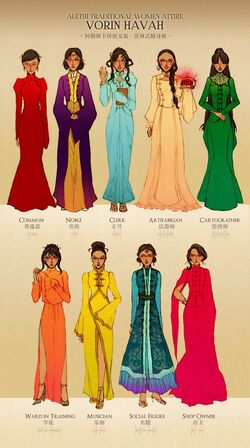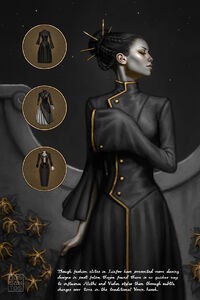
Alethi Traditional Women Attire
Vorin Havah
Fan art by botanicaxu[1]
The Vorin havah is worn by Alethi and Veden lighteyed women. The havah is a one piece dress, described as being made of silk and having a sleek fit. They are fitted in the bust, waist, and torso, but the skirts are full.[1] The hemline reaches a woman's feet and the neckline is almost at her chin. Like the militarily inclined coats of Vorin men's fashion, havahs also have a high collar and buttons up the side. Finally, havahs also have a replaceable hem, and of course the long left sleeve to cover the safehand.
The havah is strictly lighteyes attire, and is noted as being an important piece of Alethi noble fashion. Some darkeyed and/or working women (like Rysn,[2] for example) would wear a glove instead of cuffing their safehands,[1] and might also be more likely to wear separates. (Some Thaylens refer to the clothing as prudish, but Shallan believes otherwise. She thinks it elegant and flattering; silk hugs the body, particularly through the bust.[3]) Lighteyed Vorin women also usually wear their hair up or bound in some way; loose hair appears to be frowned upon, based on the reactions Shallan receives when she flees the Palanaeum.[4] Alethi women favor particularly complex weaves, sometimes with Stormlight-infused gems, hair ornaments (often gold), and hair ribbons (which may be more popular among younger women, since they're seen mostly on women with whom Adolin associates, or with his friends at court).
Bright colors and contrast both seem common, although a havah is made from a solid swath of silk. The collar is high and cups the neck, and is often heavily embroidered, as seen on Shallan, Jasnah, and Janala. It is possible that embroidery may be used as decoration in other places as well, since it is common and fashionable, especially among the Alethi. The contrasting embroidery is usually of a bright or metallic nature.
That the hem is replaceable is an interesting detail; a logical explanation would be that the fabric gets dirty and ragged while walking around. To replace the hem to match the rest of the havah exactly in color, and to make the seam discreet, might be an expensive process, and so a contrasting hem could be popular. Another option might be to find a matching fabric but embroider it, although that might be more expensive than matching the hem and making a discreet seam. The skirts are full but sleek; perhaps if fuller skirts were desired or needed, but the shape of the garment needed to be retained, godets (i.e., extra pieces of fabric in the shape of circular sectors which are set into the garment) could be inserted below the hips. Shallan and Jasanah are both described as wearing slippers, so slippers would probably be common footwear among other Vorin women.

Folio: The Vorin Havah
Artwork by Dan dos Santos[5]
Havahs are described as buttoning up the sides of the torso, from waist to neck. In one example, it only buttons on the right side, while the rest of the buttons on the left are decorative, and just below the hip the main front piece joins the back piece in a side seam.
Possibly, the most distinguishing feature of havahs is the left sleeve, since it protects the safehand for Vorin women. This sleeve is described as being longer than the right sleeve, and as an oversized cuff that buttons closed. A woman's safepouch also buttons on the inside of it. In Vorinism, symmetry is sacred, so the sleeves of havahs are mostly the same in appearance. They could probably take several forms, alternately more flowing or more narrow. How the sleeve terminates could, again, be different depending on the individual and societal preferences; the end of the sleeve might look like a loose approximation of the shape of the hand or it might be more bell-shaped, with a linear sort of hem. A sleeve's safepouch is described as being able to be buttoned into the sleeve by Shallan[6] and as "an envelope-like cloth container."[7] The amount of buttons that close the left sleeve might be somewhat standardized, or kept consistent by the woman herself, and so a strip with an equal number of buttonholes would allow the pouch to simply be placed over the buttons before the sleeve is closed. Placing the closure to the pouch itself closer to the seam, and therefore the woman's thumb and index figure, would allow her to have easy access to the contents.
The practice of hiding the safehand is not started right away in a Vorin girl's life; although the age of Taravangian's granddaughter is not mentioned, Shallan notices that she is "too young to have a modesty sleeve."[8] Presumably, girls start wearing dresses with modesty sleeves around age 15; assuming that Laral is around the same age as Kaladin, she would be approximately that age when readers first see her wearing one. Modesty sleeves seem to be preceded by a glove, which girls begin wearing around age 13; there is a reference to this in Laral’s case.[citation needed] It is also interesting that although symmetry is prized so highly in Vorinism, havahs are not quite symmetrical; they are rather like ideal lighteyes' names, which are one letter off from perfect symmetry, and havahs are just slighty off from perfect symmetry because of the long left sleeve.
Lastly, cosmetics do not seem to be uncommon; references to them are limited, but Jasnah and Navani are both mentioned to be wearing lip paint, and Hashal has painted nails. Jasnah also wears blush at one point. There is not enough information to know exactly how widespread the use is, but thus far cosmetics appear to be neither rare nor condemned.[9]
The inscription on the image reads as follows: "Though fashion elites in Liafor have presented more daring designs in past folios, they've found there is no quicker way to influence Alethi and Veden styles than through subtle changes over time in the traditional Vorin Havah."[5]
References[]
| |||||||||||||||||
